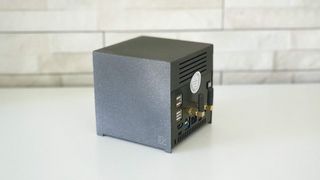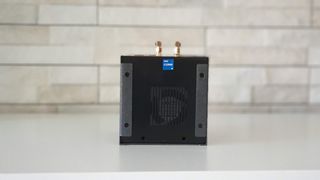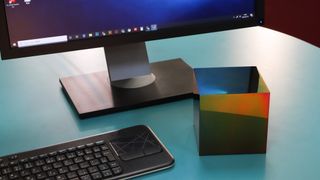TechRadar Verdict
The Bleujour Kubb Gen 11 is a unique piece of technology and easily justifies its more expensive price tag with better components, small touches (like dual TB4 and external antennas) and a finish that makes it stand head and shoulders above the competition when it comes to design.
Pros
- +
Stunning performance
- +
Design stands out in a good way
- +
Plethora of finish
- +
Three-year warranty
- +
External antennas
- +
Thunderbolt 4
- +
2.5Gb LAN
Cons
- -
Single channel configuration
- -
USB 2.0
- -
No front facing ports
- -
No card reader
Why you can trust TechRadar
Some computers are designed to be hidden behind a desk or a monitor. Others are conceptualized as works of art; the 1998 Apple iMac G3 or the Dell Adamo from 2009 fall in that category. Another small vendor wants to join that club where technology meets aesthetically pleasing designs. Bleujour, a French startup, unveiled a number of products in 2019 including the Kubb, a range of micro desktop PCs, with a twist.
Price and availability
Bleujour sells the Kubb Gen 11 direct with a jaw dropping choice of 12 shells; from the mesmerizing shell 12 to the iconic miroir which, the company says, was inspired by the historical Palais des Glaces of Versailles in Paris. The outer surface of the product is a set of mirrors. Our sample retailed for 911.95 Euros (around $1,116, £790, AU$1,440) excluding shipping (or any taxes that authorities might charge) and came with Linux Mint installed. Opting for Windows 10 Pro (there’s no option for home) carries an extra fee.

Design
Bleujour has three types of Kubb PC; the essentielle, the wood and the fanless edition. The external shell is the main difference, allowing the small PC vendor to offer more than 20 types of computers with a unique array of material. The company prides itself so much about its boutique status that it sticks a label that translates into “Authentic product hand crafted, unique piece” on all its products.

The unit we received has a black finish and the outer metal shell is anthracite with a slightly grainy texture. It is a hard wearing plate that’s about 2mm thick with sharp and pointed corners and nothing to distract the user other than the tiny kubb logotype. Bleujour states that it uses aluminum and inox as base materials.

There’s no front I/O, which is a minor annoyance, and the power button and the connectors are located at the back: six USB ports (with only one of them a USB 3.2 Gen 2), two Thunderbolt 4 ports, two HDMI ports (supporting 4K at 60Hz), two external antennas and a 2.5GbE port, powered by an Intel i225-LM chip. Sadly, there’s no card reader.

The rear and the bottom of the Kubb contain slits that allow air to flow through the chassis. Despite its relatively small volume (12 x 12 x 12cm/14cm with antenna), it weighs a rather hefty 1.1Kg due to its choice of materials.
Hardware
Here are the full specs of the Kubb Gen 11:
CPU: Intel Core i5-1135G7
Graphics: Intel Iris Xe
RAM: 16GB DDR4
Storage: Seagate Firecuda 520 500GB NVMe PCIe 4.0 SSD
Ports: 5 x USB 2.0, 1 x USB 3.2, 2 x USB-C, 2 x HDMI 2.0, 1 x Gigabit Ethernet
Connectivity: Intel AX201, 802.11ac Wi-Fi 6, Bluetooth 5.1
Weight: 1.1kg
Size: 12 x 12 x 12cm (H x W x D)
The Kubb is available with Intel Core processors (8th or 11th generation); the unit we tested came with an Intel Core i5-1135G7. That’s a Tiger Lake 10nm quad-core, octo-thread processor with a maximum clock speed of 4.2GHz and a TDP of up to 28W.
It comes with an integrated Irix Xe Graphics (which supports 8K resolutions), 16GB DDR4-3200 memory (a lonely 16GB Adata SODIMM D23.27553S.001 PC4-25600 module), a 500GB NVMe PCIe 4.0 SSD (Seagate Firecuda 520), Wi-Fi 6, Bluetooth 5.1 (via Intel’s AX201) and a 120W brick power supply unit.
You should be able to add a secondary 2.5-inch SSD/HDD if you want to increase the internal storage capacity. Note that the device also comes with a cable organizer and a HDMI cable.
The Kubb Gen 11 appears to be built on the Intel NUC11TNHi5 NUC (Next Unit of Computing) which is sold at Avadirect for under $900 with a similar configuration (including a PCIe x4 SSD).

In use and performance
The device comes with Windows 10 Professional but you can save 185 Euros by opting for the Mint Linux distro. Bleujour also provides a three-year warranty although details on what that entails are scant on the website. We reached out to them to find out.
Here’s how the Kubb Gen 11 performed in our suite of benchmark tests:
CPU-Z: 562 (single-thread); 2620 (multi-thread)
Geekbench: 1261 (single-core); 4244 (multi-core); 11682 (compute)
CrystalDiskMark: 5009MBps (read); 2533MBps (write)
Cinebench CPU: 2080
Novabench: 2050
PCMark: 4470
3DMark: 1139 (Timespy); 2632 (Firestrike); 11209 (Nightraid); 9035 (Skydiver)
Passmark: 5108 (Overall); 11801 (CPU); 2380 (GPU 3D)
Atto: 2310MBps (read, 256mb); 5110MBps (write, 256mb)
Windows Experience Index: 8
The Kubb performed beyond our expectations with Intel’s 11th generation platform easily besting previous ones by a wide, very wide margin. For example, the single thread score of the Core i5-1135G7 was competitive with the Core i7-10870H that powered the XMG Pro 17, a mobile workstation.
The graphic subsystem was another highlight of the test with 3DMark numbers vastly superior to anything Intel produced to date. It bested the UHD graphics found in the Core i5-10210U by as much as 150%, that translates into smoother graphics and the ability to play even recent games at low resolutions.
The star of the show though has to be the Seagate Firecuda 520. This PCIe 4.0 SSD is a beast of a drive hitting a staggering 5GBps read transfer rate on CrystalDiskMark, our highest number to date.
Final verdict
If you aspire to have a computer that looks like a work of art on your office desk then welcome to the world of Bleujour. In this day and age of interacting with other human beings through video conferencing and webcams, the Kubb is a refreshing tactile and visual experience and to try and evaluate it as a “normal” computer would go against the very quintessence of why Bleujour exists in the first place.

It is unashamedly French and proud of its artistic and cultural heritage with the base plate and the shell both designed and manufactured in France. The product page is awash with videos and pictures showing artisans at work with paint sprays and tools. They even have an exclusive shell made for Sony Japan.
The Kubb is a stunner and unabashedly focused on looks but not at the expense of performance. The combination of an upgraded video chip, PCIe 4.0 SSD and smaller manufacturing node (10nm compared to 14nm) delivered some very, very good results.
Great to see not one but two USB 4.0 ports and a 2.5G LAN port as well as external antennas for improved Wi-Fi reception. That doesn’t mean that this is a perfect product, far from that. There’s no reason why a 2021 product carries so many USB 2.0 ports and ditto for the single channel memory configuration. We’re a bit more understanding of the lack of a card reader and front USB.
- We've also featured the best thin clients

Désiré has been musing and writing about technology during a career spanning four decades. He dabbled in website builders and web hosting when DHTML and frames were in vogue and started narrating about the impact of technology on society just before the start of the Y2K hysteria at the turn of the last millennium.

